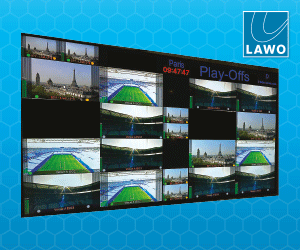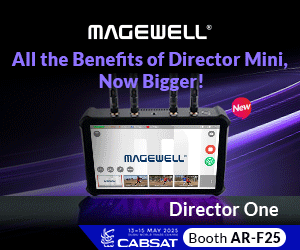When English Heritage opened the new attraction at Dover Castle, “Operation Dynamo: Rescue from Dunkirk,” it deployed around $700,000 worth of audio-visual equipment to recreate the drama of World War IIs Dunkirk evacuation a case-study Situated in the network of 60-metre long secret tunnels, 26 metres underground behind the famous White Cliffs of […]

When English Heritage opened the new attraction at Dover Castle, “Operation Dynamo: Rescue from Dunkirk,” it deployed around $700,000 worth of audio-visual equipment to recreate the drama of World War IIs Dunkirk evacuation a case-study
Situated in the network of 60-metre long secret tunnels, 26 metres underground behind the famous White Cliffs of Dover, the attraction at Dover Castle in English county of Kent, makes extensive use of AV technology to present the events of May 26 to June 4, 1940. In the highlight of the attraction, 23 projectors create giant images that run the entire length of the space augmented by spectacular lighting effects. German fighter planes appear to zoom down the entire length of the tunnel immersing visitors in the action on the Dunkirk beaches, while another scenario shows eerie-silhouetted figures hunched over a table planning the evacuation from within the tunnels.
Challenging working conditions
Electrosonic and Denmark based Kvorning Design & Communication designed and produced the new attraction. The project posed some difficult challenges, including working in a historic site, dealing with the climate underground and projecting images in spaces where no surface is straight. During the design phase, Electrosonics Design Consulting team worked with Kvorning to determine the audiovisual solutions to meet their creative designs. The design works included AV and control design in sufficient detail to allow reliable budgeting and form the basis of tender documents.
Full-sized tests needed to be conducted and 3D CAD techniques were used to model the projection optics. “Providing a series of audiovisual experiences in the listed tunnels underneath Dover Castle has presented some very unique challenges,” says Dirk Bennett, acting head of interpretation at English Heritage. “Electrosonic has provided the expertise, experience and creativity to come up with solutions which will create an immersive and exciting experience unique in the area of heritage interpretation.” Dover Castle is known as “The Key to England” in its role as guardian of the nearest landing point to mainland Europe. The tunnels at Dover Castle were begun in 1797 when Britain faced the possibility of invasion by the French army of Napoleon Bonaparte. The tunnels formed safe underground barracks for British troops. Most importantly, it was the place where the rescue of the British army from Dunkirk was planned in 1940.
Show divided into eight zones
“Operation Dynamo: Rescue from Dunkirk” takes parties of up to 30 people at a time through eight zones featuring original newsreels, recordings, veterans testimonies and special effects, which portray the rescue of the British army from Dunkirk, France planned in the Dover Castle tunnels. The show begins in The War Begins cinema, an underground briefing room with a mock 16mm projector and blackboard, the latter actually an LCD panel covered in black gauze, which displays the events leading to war. After passing through a corridor of tunnels, visitors arrive in an underground war room for The Battle of France presentation.
Two walls of the large space show archival footage; animated graphics are projected onto a low table in the center of the room by a Panasonic 6300 projector. As the presentation ends and the crisis builds, images spill over the table to fill the pyramidshaped sides of the table. The highlight of the attraction is Rescue from Dunkirk Casemate set in one of the 60-meter long tunnel spaces or casemates. Giant images are displayed on the entire length of the tunnel via 23 Optoma EX785 DLP projectors, computer controlled to ensure synchronisation and to warp and blend the images into one long panorama. Spectacular lighting effects augment the projections, which include fighter planes that appear to zoom down the entire length of the tunnel against a backdrop of ships and small boats. In another sequence, silhouetted photos give the eerie feeling that those planning the evacuation are still present in the tunnels.
Audio in these zones was designed by Electrosonic to meet the needs of Kvornings sound designer. Sound is used not only for narration and special effects but also to draw visitors through the space. After the show concludes, visitors are free to circulate in Aftermath zone areas that depict how the tunnels were used following the evacuation, especially during the Battle of Britain. LED lighting simulating original filament lamps is particularly evocative here. The exhibits are supported by ambient audio, display panels and video “labels” that display films showing how the spaces were used during the war. All have English, French and German soundtracks. Additional interactive displays overlook Dover Harbor in the exhibition space above the gift shop; a series of listening points allow visitors to hear the oral testimonies of veterans. “We have worked in close and positive collaboration with Electrosonic on the AV installation in the secret wartime tunnels,” notes Kvorning Designs Arne Kvorning. “As a team weve jointly created one of the largest permanent projection set ups in Europe. The experience is absolutely breathtaking, bringing the history of the tunnels to life.” For the project, Kier was the main contractor for the associated building works, COWI and the Light Bureau were the lighting designers, Stouenborg the audio designer and producer, Kvorning and Homerun the media producers, and MDM the creators of the special effects and set work.

Q & A with Arne Kvorning of Copenhagen-based Kvorning Design & Communication
Museums, especially on-site recreations such as the one in Dover must pose special challenges but they are probably more exciting than generic museums. What were the big challenges in the Dover project?
The Secret Wartime Tunnels at Dover Castle is an interesting mix of recreated spaces and casemates with intensive use of projections. The main challenge was recreating the battle scenes on the beaches of Dunkirk. It is all created from original footage combined with advanced 2D and 3D-animation techniques.
Reportedly $700,000 was spent on AV equipment. In terms of the total cost of the project, how would you rate the equipment used?
Almost half of the total budget was used on AV equipment and I think we achieved to give the client English Heritage a unique and priceless visitor experience.
Can the museum authorities change or modify any of the exhibits?
The museum has all rights to modify the content and the displays but they will hopefully come back to Kvorning Design & Communication whenever they want an update. This is a work from the heart for us.
How crucial is the client brief in this regard is it purely in terms of content? What point of reference did you have to execute the project?
In this case the client brief was only in terms of content. It was our own EX785 DLP projectors, computer controlled to ensure synchronisation and to warp and blend the images into one long panorama. Spectacular lighting effects augment the projections, which include fighter planes that appear to zoom down the entire length of the tunnel against a backdrop of ships and small boats. In another sequence, silhouetted photos give the eerie feeling that those planning the evacuation are still present in the tunnels. Audio in these zones was designed by Electrosonic to meet the needs of Kvornings sound designer. Sound is used not only for narration and special effects but also to draw visitors through the space.
The project posed some difficult challenges, including working in a historic site, dealing with the climate underground and projecting images in spaces where no surface is straight ambitious idea to create this experience probably the largest permanent AV installation in Europe. We have actually never seen anything like this in a museum environment before.
Full-sized tests were conducted and 3D CAD techniques were used to model the projection optics was this during the tender process?
The projections were tested in both 3D environments and in full-size in the tunnels but it was not possible to do these tests in the tender procedure. When we won the project we installed a full-size mock-up of a tunnel section for test projections in Copenhagen and based on that we conducted a full-scale test in the tunnels. The final adjustments were made using the Watchout software.
What makes for an effective AV-led solution in museum spaces?
The AV-installation at Dover Castle is rather complex but it is effectively timed and managed by the show control. The client has full control over the system using a simple interface.
Personally, how would you rate this project given your experience in this sector?
The project at The Secret Wartime Tunnels is one of the largest AV-based visitor experiences we have created. It has not been easy, but the process and the results made it worth it. Denmark based Kvorning Design & Communication designed and produced the new attraction and Electrosonic was the AV systems integrator.















































































